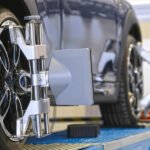

The Lowdown on Low-Profile Tires: Are They Worth the Hype ?
Low-profile tires, with their sleek sidewalls and sporty appearance, have become increasingly popular in recent years. But before you succumb to their aesthetic allure, it’s crucial to understand the potential downsides of this trendy tire choice.
What are low-profile tires?
Low-profile tires are characterized by a shorter sidewall height relative to the tread width. This means the rubber sidewall, which cushions the tire against impact, is significantly thinner compared to standard tires. While the exact definition varies, low-profile tires typically have an aspect ratio (the ratio of sidewall height to tread width) of 55 or lower. For example, a 225/45R17 tire has an aspect ratio of 45, indicating that the sidewall height is 45% of the tread width.
The appeal of low-profile tires
There’s no denying the undeniable aesthetic appeal of low-profile tires. They give cars a lower, more aggressive stance, enhancing the overall sporty look. Additionally, they offer several performance advantages:
- Improved handling: The stiffer sidewalls provide sharper turn-in and better cornering stability, especially at high speeds.
- Enhanced responsiveness: The reduced sidewall flex translates to quicker steering response and more precise control.
- Potentially increased fuel efficiency: The lower rolling resistance of low-profile tires can slightly improve fuel economy.
The not-so-glamorous side of low-profile tires
However, the allure of low-profile tires comes with a set of trade-offs that shouldn’t be ignored.
Compromised Ride Quality:
One notable drawback of low-profile tires lies in their impact on ride quality. The thinner sidewalls offer less cushioning, resulting in a harsher and bumpier ride, particularly on uneven or rough roads. The reduced ability of these tires to absorb shocks can lead to a less comfortable driving experience compared to vehicles equipped with standard tires.
Increased Susceptibility to Damage:
Low-profile tires, with their reduced sidewall height, become more vulnerable to various forms of damage. Potholes, curbs, and other road hazards pose a greater risk to these tires, increasing the likelihood of punctures and sidewall damage. The compromised ability to absorb impacts exposes the tire to a higher risk of harm, potentially leading to more frequent repairs or replacements.
Shorter Lifespan:
The design of low-profile tires often includes thinner sidewalls and softer rubber compounds. This characteristic results in a shorter lifespan compared to standard tires. The reduced durability makes low-profile tires more prone to wearing out faster, necessitating more frequent replacements. This factor can contribute to higher maintenance costs for vehicle owners over time.
Higher Replacement Cost:
Choosing low-profile tires comes with a financial trade-off. These tires are generally more expensive than their standard counterparts, both at the time of initial purchase and when replacement is required. The added cost can significantly impact the overall expenses associated with owning a vehicle, making low-profile tires a less economical choice for budget-conscious consumers.
Potential Compatibility Issues:
Not all vehicles are well-suited for low-profile tires, and their use may lead to compatibility issues. Depending on the vehicle’s suspension design and specifications, opting for low-profile tires might negatively impact handling and performance. Additionally, there is a risk of rubbing issues, where the tires may come into contact with other components or the vehicle’s body, potentially causing damage and affecting overall driving safety.
So, are low-profile tires right for you ?
If you prioritize performance and aesthetics above ride comfort and are willing to pay the premium in terms of cost and potential maintenance, then low-profile tires might be a good choice for you. However, if you value a comfortable ride, drive primarily on rough roads, or are on a budget, standard tires are likely the more practical option.
Add a comment Cancel reply
Categories
- Car Gadgets (17)
- Car News (33)
- Car Reviews (43)
- Car Wars (7)
- Mechanicals (32)
- Uncategorized (2)
Recent Posts
About us

Popular Tags
Related posts


Essential Car Repair Skills Every Driver Should Know

All About Wheel Balancing








